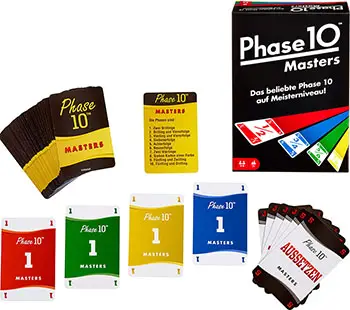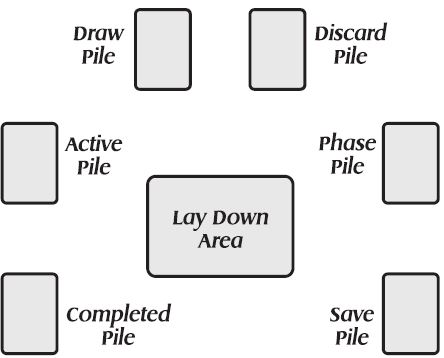

Components
- 24 red Phase Cards
- 24 yellow Phase Cards
- 24 green Phase Cards
- 24 blue Phase Cards
- 2 skip cards
- 8 wild cards
- Instructions
Object of the Game
To be the first player to complete all 10 phases, in case of a tie, the player with the lowest score is the winner.
Setup
Each player is given a set of colored Phase Cards that include all 10 phases.
Example Play Area setup:

One player is chosen to be the dealer, who shuffles the deck and deals each player a hand of ten cards. Players hold their cards in hand, so that the other players cannot see them.
The remaining deck is placed face down in the center of the play area, to become the draw pile. The top card of the draw pile is turned over and placed face-up next to the draw pile, to become the discard pile.

Game Play
Play begins with the player to the left of the dealer playing first Play continues in a clockwise direction, in turn each player examines their hand and Phase Cards and determines which phase he/she will attempt by placing the appropriate Phase Card in the Active Pile in the Play Area.
Once all players have placed a Phase Card in their Active Pile, play begins.
in turn, a player draws a card-either the top card from the Draw Pile or the top card from the Discard Pile or one of their cards from the Save Pile-and adds it to the player's hand. The player ends the turn by discarding one card of choice onto the Discard Pile or adding it to their Save Pile.
Phase & Phase Cards
There are ten phases. Each phase is described on the Phase Cards. Each player starts the game with ten Phase Cards, one for each of the ten phases.

Players will try to complete the phase on the Phase Card in their Active Pile. Each Player may attempt only one Phase Card during the play of a hand. Phases are made of Sets, Runs, Cards All of One Color, or a Combination of Sets and Runs.
Making (Completing/ a Phase
if during the turn, a player makes (completes) the phase on their active Phase Card with the cards in hand, the player may lay it down, face up on the table in front of them.
For example, the player is hying to make Phase 1 and has three '5's' and two "7's", and draws a '7'. The player now has two sets of three and may lay them down.
Note: A player may never lay down part of a phase, but must have the whole phase in hand before laying it down.
A player may lay down more than the minimum requirements of a phase but only if the additional cards can be directly added to the cards already in the phase.
Only one phase can be made (completed) per hand, if a player successfully makes a phase in a hand, then the player will wait until that hand is finished before choosing a phase to attempt for the next hand, if a player fails to make the phase in a hand, the player must remove the phase Card from their Active Pile and place it in their Phase Pile.
A player receives credit for making a phase as soon as the player lays down the phase. The player does not need to win the hand in order to receive credit for the completed phase.
Several players will often complete a phase in the same hand. Once a player completes a phase, the player will move the Phase Card to their completed Pile.

Saving Cards & Save Pile
A player may save a card any time during their turn by saying 'save'. The player should then place the card in their Save Pile, when a player saves a card it counts as their discard for that turn, so their turn is over.
Players are allowed to save only one card per hand, players are allowed to look at their own saved cards at any time, but they can not look at any other player's saved cards.
The advantage of saving cards is that players may use them later. A player may use a saved card in this way: when it is the player's turn instead of drawing from the Draw or Discard Piles, the player draws one card of their choice from their save Pile.
A player may only draw one card per turn from their saved Pile. The player must announce that they are drawing a saved card by saying, 'I'm drawing a saved card'. The players turn would continue as normal, ending with their discard.
Hitting
Hitting is the way to get rid of leftover cards in the hand after making a phase A player makes a hit by laying down a card directly on any phase already laid down. The card must property fit in with the cards already down.
Before a player can make a hit, the player's own phase must already be laid down. A player may hit only during their own turn. You may hit your own cards, another player's cards, or both.
Going out / Finishing a Hand
After laying down a phase players try to "Go Out* as soon as possible. to go out, you must get rid of all of your cards, by discarding or hitting on an existing laid down phase.
The player going out first wins the hand. The winner of the hand, and any other players who also completed their phase, will move the Phase Card from their Active Pile to their Completed Pile.
Those players not completing their phase, must place their Phase Card onto their Phase Pile, to be attempted again. However, the player is not required to try it again on the next hand, but may choose any Phase Card in their Phase Pile.
Scoring:
Paper and pencil are needed for scoring, and a running total for each player is kept The winner of the hand scores zero. All other players score points against them, for cards still in hand, as follows:
- 5 points for each card numbered 1-9
- 10 points for each card numbered 10-12
- 15 points for each Skip card
- 25 points for each Wild card
Only cards in hand are scored, not cards already laid down. After scores are recorded, the player to the left of the last dealer becomes the new dealer. All cards, excluding any Saved Card, are gathered and shuffled, and a new hand is dealt
End of the Game
when, at the end of a hand, a player has completed all ten phases and has no more Phase Cards in their Phase Pile, that player is declared the winner.
If two or more players complete all ten phases in the same hand, then the player with the fewest points against them is the winner.
Continue Reading


